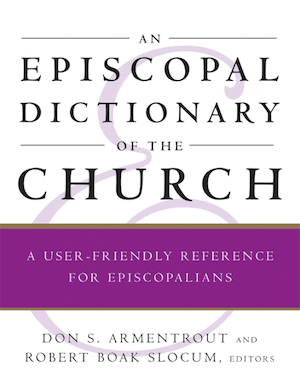Glossary of Terms
Three-Decker Pulpit
A structure in which the clerk's pew was on the lowest level, the officiant's reading pew was on the middle level, and the pulpit was on the highest level. It […]
Throne, Episcopal
The bishop's official and ceremonial seat. It is also known as the cathedra, from the Latin for chair. It is typically located in the cathedral of the diocese. The term […]
Thurible
A small metal pot on chains in which incense is burned during the eucharist and other liturgies. The thurible is also known as a censer. The term is derived from […]
Thurifer
The server or acolyte who carries and swings the thurible in which incense is burned during the eucharist and other liturgies. The thurifer, the celebrant, the deacon, or other ministers […]
Tiffany Window
A stained glass window by the American artist Louis Comfort Tiffany (1848-1933). Tiffany was a native of New York City. He used an original process for making opalescent glass which […]
Tiffany, Charles Comfort
(Oct. 5, 1829-Aug. 20, 1907). Episcopal Church historian. He was born in Baltimore, Maryland. Tiffany received his M.A. from Dickinson College in 1853. He studied at the Andover Theological Seminary. […]
Timothy
(1 Thes 3:2; see also Rom 16:21). He is credited by Paul with co-authoring Paul's Second Letter to the Corinthians, and Paul's Letters to the Philippians, the Colossians, and to […]
Tindal, William
(See Tyndale, or Tindal, William.)
Tippet
A large black scarf worn by clergy over surplice and cassock at the Daily Offices. It resembles a stole and is worn around the neck with the ends hanging down […]
Tithe
A tenth of a person's income, usually mandated for sacred purposes. Tithing was a practice in Israel but not unique to Israel. It was well known throughout the ancient Near […]
Titus
(2 Cor 8:23). Titus and Barnabas went with Paul to Jerusalem at the time of the apostolic council (c. 50) (Gal 2:1). This council decided to accept Gentiles as full […]
Tohuku, Missionary District of
The House of Bishops voted on Oct. 27, 1920, to divide the Missionary District of Tokyo and establish the Missionary District of Tohoku. In Apr. 1941 the Missionary District of […]
Tokyo, Missionary District of
The 1872 General Convention established the Missionary District of Yedo in Japan. In 1893 the name was changed to the Missionary District of Tokyo. On Oct. 15, 1925, the name […]
Tonsure
A traditional shaving of the head for monks and diocesan clergy. The tonsure was a point of friction between Celtic and Latin monks in the British Isles of the seventh […]
Tonus Peregrinus
A Latin title for a medieval psalm tone. In translation it means a foreign or wandering tone. In the psalm tone, Tonus peregrinus, there is a different pitch for the […]
Torah
A Hebrew noun coming from the verb “to teach.” It has the basic meaning of teaching or instruction, but it is usually translated law. Although in the OT it can […]
Torch Bearer
An acolyte or server who carries a torch in procession, including the gospel procession. See Torches.
Torches
Candles mounted on poles for use in the liturgy. Lighted torches may be carried by acolytes or servers in procession, including the gospel procession. Torches may be placed near the […]
Tory
See Loyalists.
Total Ministry
A model of pastoral oversight based on the development of the ministry of the whole church, lay and ordained. This model seeks to provide a comprehensive program for the education […]
Glossary definitions provided courtesy of Church Publishing Incorporated, New York, NY,(All Rights reserved) from “An Episcopal Dictionary of the Church, A User Friendly Reference for Episcopalians,” Don S. Armentrout and Robert Boak Slocum, editors.

